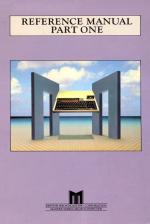
Acorn User
 1st October 1986
1st October 1986
Categories: Review: Book
Author: Steve Mansfield
Publisher: Acornsoft
Machine: BBC Master 128
Published in Acorn User #051
Refer To The Master
After I unpacked my Master I carried on looking around the box thinking that there must be a proper manual in there somewhere. Not I've got not one but two fairly decent manuals. The catch is that I had to fork out £15 for each of them.
Even so, they still don't cover two of the most important features of the Master, the View and ViewSheet programs built into the firmware. You're going to have to dip into your wallet to the tune of another £25 for that vital information.
It doesn't take a mathematical genius to work out that the real cost of a Master is not £500 but £555. It's true that some Master owners won't want the technical information in the reference manuals. Some may already have manuals for the firmware, having bought it for Beebs they already own, and some may never use ViewSheet.
Beeb owners, however, are pretty serious about their machines and usually want to get the most out of them. Acorn has given us a sophisticated machine and then offered to tell us how to use it - at a price.
The catch is that, for some time at least, you won't be able to get the information held in the reference manuals anywhere else. There are important differences between the Master and the Beeb at all levels, from Basic down to the Operating System. You can't simply get one of the plethora of detailed books about the Beeb and hope that the information holds good for the Master.
Perversely, the Reference Manual Part Two came out first. It is mainly concerned with Basic programming, with sections covering all aspects of BBC Basic - from keywords to error messages. In that respect it is reminiscent of the User Guide, but goes further, with detailed information on how Basic uses memory and the MOS.
The Basic keyword section is possibly the most heavily used part of the manual by beginners and even some advanced programmers. All the information is here, including syntax and examples. However, unlike the User Guide, each keyword is not given a separate page. In addition, the text fonts used don't really highlight each command, so finding the one you want is a slow business.
The assembler is covered in a similarly exhaustive way. Each keyword available with the 65C12 in the Master is described along with descriptions of flags affected and addressing modes available.
The other two sections of the Part Two manual cover the built-in Edit program and the terminal emulator. The former turns out to be very versatile indeed, with sophisticated formatting commands - something not even hinted at in the Welcome Guide.
As well as its use for editing Basic programs and other languages like Pascal, the edit program is a flexible word processor. The manual does it justice, with clear descriptions of all the features.
The section on the Terminal program is less useful. The program is fairly crude. Although it can prove adequate for communicating with peripherals, like the Scorpion robot controller, anyone wanting to get into comms will need something else. The manual is pretty exhaustive though; it includes a great deal of detailed information on escape codes and sequences.
All that aside, it's the Reference Manual Part One that most people will have been dying to get their hands on (apart from the mythical Advanced Reference Manual).
Part One gives the lowdown on the MOS and filing systems, including details on all the OS calls. OSBYTE, OSWORD and VDU commands are given a detailed treatment similar to that meted out to Basic keywords in the other volume.
A general chapter on the filing systems is followed by specific chapters on the cassette, ROM and disc systems in the Master. The latter covers both DFS and ADFS, and all chapters include a section on using the filing systems from assembly language.
The style is familiar from the old BBC User Guide, although this time Acorn has adopted a cumbersome page numbering system. It works well enough when you are simply looking for a general section. But finding a specific page mentioned in the index is slower than if ordinary page numbers had been used.
The manuals are about the size of the User Guide and they suffer from a similar binding problem. After about a week's ordinary use the pages start to work their way off the ring binding, so the manual never closes properly after that.
Between them, the guides cover the same sort of ground that the User Guide and Advanced User Guide did with the Beeb. However, most of this information should have come free with the machine.




